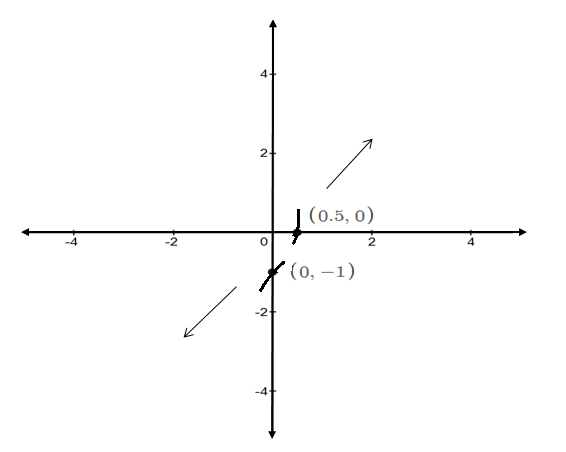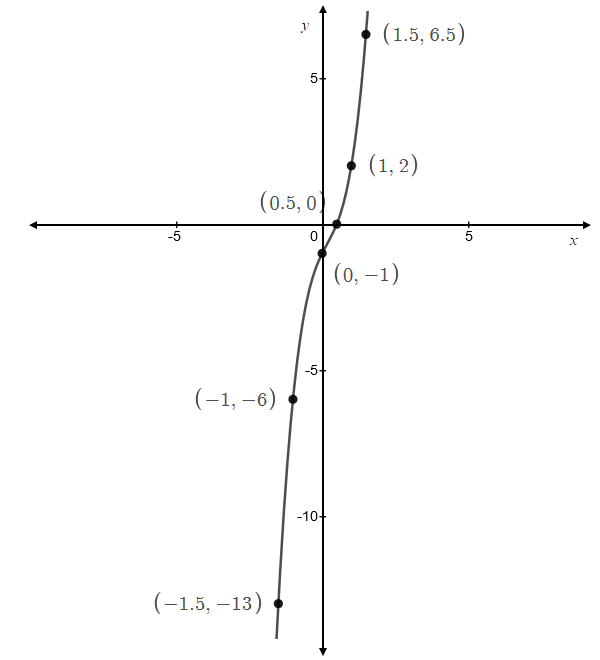
Concept explainers
Mixed Practice In Problems
To graph: The polynomial function
Explanation of Solution
Given Information:
The polynomial function
Graph:
The steps of graphing the polynomial function as follows:
Step 1: First, find the end behavior of the graph of the function
Here, the degree of the polynomial function
The graph of the function
Step 2: Find
For the
Thus, the
For the
The degree of the polynomial
Since there are 3 variations in the sign of the non-zero coefficients of
There is no variation in the sign of the non-zero coefficients of
By using the Rational Zero Theorem, all possible rational zeroes are of the form
In the polynomial
Factors of the constant term
Factors of the leading term
Therefore, all the possible rational zeros are:
Simplifies to
As there is no negative real zero, all the potential rational zeros of the polynomial function
Now, test
Here, since the remainder is 2,
Now, try
Here, since the remainder is 0,
To write the factors of
Here,
Any solution to this depressed equation is also a zero of
This depressed equation
This does not give a real solution.
Thus, the real zeros, that is,
Step 3: The maximum number of turning points on the graph of the function
since the polynomial function
The polynomial function
Step 4: Now, use the information obtained in step 1 to 3 to draw the graph of the function

Now, find additional points on the graph.
For
For
For
For
Now, plot all these coordinates
So, the graph of the function is obtained as follows:

Interpretation:
The graph represents the polynomial function
Chapter 4 Solutions
Precalculus
Additional Math Textbook Solutions
College Algebra (7th Edition)
Introductory Statistics
Elementary Statistics: Picturing the World (7th Edition)
Basic Business Statistics, Student Value Edition
A First Course in Probability (10th Edition)
A Problem Solving Approach To Mathematics For Elementary School Teachers (13th Edition)
- Let the region R be the area enclosed by the function f(x)= = 3x² and g(x) = 4x. If the region R is the base of a solid such that each cross section perpendicular to the x-axis is an isosceles right triangle with a leg in the region R, find the volume of the solid. You may use a calculator and round to the nearest thousandth. y 11 10 9 00 8 7 9 5 4 3 2 1 -1 -1 x 1 2arrow_forwardLet the region R be the area enclosed by the function f(x) = ex — 1, the horizontal line y = -4 and the vertical lines x = 0 and x = 3. Find the volume of the solid generated when the region R is revolved about the line y = -4. You may use a calculator and round to the nearest thousandth. 20 15 10 5 y I I I | I + -1.5 -1 -0.5 0.5 1 1.5 2 2.5 3 -5 I -10 -15 I + I I T I I + -20 I + -25 I I I -30 I 3.5 4 xarrow_forwardplease show all the workarrow_forward
 Calculus: Early TranscendentalsCalculusISBN:9781285741550Author:James StewartPublisher:Cengage Learning
Calculus: Early TranscendentalsCalculusISBN:9781285741550Author:James StewartPublisher:Cengage Learning Thomas' Calculus (14th Edition)CalculusISBN:9780134438986Author:Joel R. Hass, Christopher E. Heil, Maurice D. WeirPublisher:PEARSON
Thomas' Calculus (14th Edition)CalculusISBN:9780134438986Author:Joel R. Hass, Christopher E. Heil, Maurice D. WeirPublisher:PEARSON Calculus: Early Transcendentals (3rd Edition)CalculusISBN:9780134763644Author:William L. Briggs, Lyle Cochran, Bernard Gillett, Eric SchulzPublisher:PEARSON
Calculus: Early Transcendentals (3rd Edition)CalculusISBN:9780134763644Author:William L. Briggs, Lyle Cochran, Bernard Gillett, Eric SchulzPublisher:PEARSON Calculus: Early TranscendentalsCalculusISBN:9781319050740Author:Jon Rogawski, Colin Adams, Robert FranzosaPublisher:W. H. Freeman
Calculus: Early TranscendentalsCalculusISBN:9781319050740Author:Jon Rogawski, Colin Adams, Robert FranzosaPublisher:W. H. Freeman
 Calculus: Early Transcendental FunctionsCalculusISBN:9781337552516Author:Ron Larson, Bruce H. EdwardsPublisher:Cengage Learning
Calculus: Early Transcendental FunctionsCalculusISBN:9781337552516Author:Ron Larson, Bruce H. EdwardsPublisher:Cengage Learning





